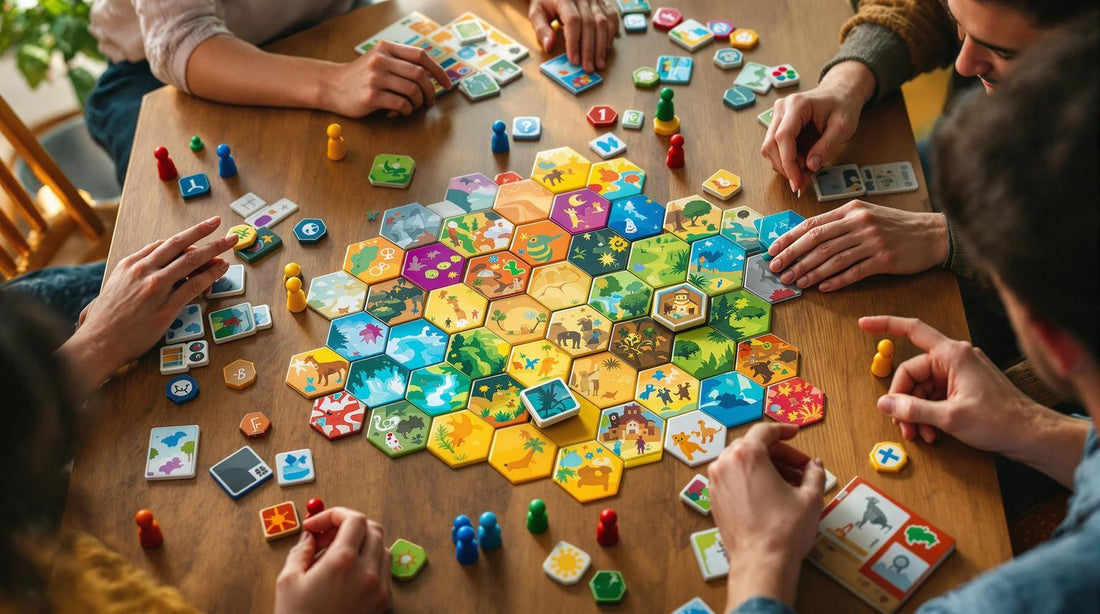Discover the Best Board Games for Every Player

Ultimate Guide to Tile Placement Games
Tile placement games are board games where players strategically place tiles to form patterns, build layouts, or achieve objectives. They are easy to learn, visually engaging, and offer a mix of strategy and fun for all skill levels. Here’s what you need to know:
- What are they? Games where tiles are placed according to specific rules to score points or complete goals.
- Why play them? Improve spatial reasoning, decision-making, and planning while enjoying social or solo gameplay.
- Who are they for? Perfect for families, casual players, strategy enthusiasts, and even solo gamers.
- Popular examples: Carcassonne, Azul, Kingdomino, and A Feast for Odin.
- How to win: Manage space, anticipate opponents' moves, and adapt strategies across game phases.
Tile placement games range from simple family-friendly options to complex strategy challenges, making them a favorite among board game lovers. Ready to dive in? Keep reading for history, mechanics, and top game recommendations.
History of Tile Placement Games
Early Games and Origins
The roots of tile placement games can be traced back to classics like dominoes and mahjong. However, the modern board game scene began to explore these mechanics more deeply with titles like Acquire (1964), which revolved around corporate-themed tile mergers. Later, Titan (1980) introduced hex-based map creation, offering a fresh way to engage with spatial mechanics. These early innovations set the stage for the genre's evolution. In 2000, Carcassonne became a breakthrough hit, bringing tile placement to mainstream audiences and introducing mechanics that remain central to the genre today.
Recent Game Developments
Since Carcassonne, designers have pushed the boundaries of tile placement mechanics. Games like Suburbia (2012) added the strategic layer of tile drafting, while Galaxy Trucker (2007) brought in real-time pressure to keep players on their toes. Spatial puzzling also took a leap forward with polyomino tiles in games such as Patchwork (2014) and A Feast for Odin (2016). Meanwhile, titles like Santorini introduced vertical stacking, adding a new dimension to the gameplay experience.
"The success of Carcassonne led to a boom in tile placement game design in the early 2000s"
Upcoming Trends
The tile placement genre is exploring exciting new directions, including:
- Legacy Elements: Games with persistent changes that carry over across multiple sessions.
- Ecosystem Themes: Mechanics that simulate ecosystems, enhancing spatial reasoning.
- Augmented Reality: Blending physical and digital gameplay for hybrid experiences.
- Educational Tools: Using tile mechanics to teach concepts, tapping into their potential for learning.
With over 3,000 tile placement games listed on BoardGameGeek, the genre shows no signs of slowing down. Many modern designs are incorporating narrative campaigns, hinting at a more immersive future for tile placement games.
Mastering Carcassonne: Starting, Placing Tiles & Meeples, Scoring Strategies
How Tile Placement Games Work
Modern tile placement games are built around three main mechanics that shape gameplay and strategy.
Getting and Placing Tiles
Players typically acquire tiles in one of two ways: random draws, like in Carcassonne, or by choosing strategically from a shared pool, as seen in Azul. Once acquired, tiles are placed according to specific rules. For example, in Kingdomino, tiles must connect terrain types to form matching patterns.
Point Systems
Scoring in these games rewards players for different strategies. Many games focus on creating patterns or controlling areas to earn points. Others, like Suburbia, use more complex scoring systems where tile placements influence multiple factors - such as income, reputation, and population - with population ultimately determining the final score.
Some games add an extra layer of strategy with bonus objectives. These can be public goals that everyone competes for or private goals that only individual players know about.
Player Interactions
Though they might seem like solo experiences, tile placement games often encourage player interaction. For instance, Galaxy Trucker introduces time-sensitive tile placement to heighten the tension. Interaction can range from competing for limited space to directly contesting resources in shared markets.
These mechanics form the foundation of what makes tile placement games engaging and strategic.
Best Tile Placement Games
Tile placement games have a rich history, offering experiences that range from light and family-friendly to deeply strategic. Here are some standout titles that showcase the variety and appeal of this genre.
Games for Families
These games are perfect for bringing everyone to the table, combining easy-to-learn rules with just enough strategy:
- Carcassonne: A timeless classic where players build a medieval landscape by placing tiles and claiming features like cities and roads.
- Kingdomino: A quick 20-minute game that uses domino-like tiles to create connected terrains. Adults enjoy the strategic choices, while kids appreciate its simplicity.
- Azul: A visually stunning game inspired by Moorish tile art, blending simple pattern-building mechanics with engaging gameplay for all ages.
Complex Games
Looking for a challenge? These titles take tile placement to the next level:
- The Castles of Burgundy: Widely regarded as a masterpiece, this game has an impressive 8.1/10 rating from over 60,000 players. It offers layers of strategic depth and decision-making.
- A Feast for Odin: A game of efficiency, where players must carefully cover their boards with tiles to maximize points.
- Terraforming Mars: While primarily a resource management game, its tile placement mechanics are integral to building interconnected systems.
New Releases
Recent entries in the genre bring fresh ideas and mechanics, reflecting the genre's ongoing evolution:
| Game | Release Year | Key Feature | BGG Rating |
|---|---|---|---|
| Cascadia | 2021 | Wildlife and terrain combo | 8.0/10 |
| Planet Unknown | 2022 | Rotating tile selection | N/A |
| Calico | 2020 | Pattern recognition | N/A |
Cascadia (2021) stands out with its unique blend of wildlife and terrain tiles, earning it an 8.0/10 rating from 22,000+ players. Planet Unknown (2022) introduces a clever rotating tile-selection mechanism, adding a layer of excitement to the gameplay. Meanwhile, Calico (2020) focuses on satisfying pattern recognition, appealing to puzzle lovers.
These modern games push the boundaries of tile placement design, especially in themes like ecosystems and innovative components. They show how the genre continues to evolve in exciting and creative ways.
sbb-itb-1ed942f
How to Win at Tile Placement Games
To succeed in tile placement games, you need to focus on three key areas: managing your space, understanding your opponents, and planning for different game phases. These games thrive on a mix of careful planning and adaptability.
Space Management
Managing your board effectively is all about balancing short-term gains with long-term goals. Keep these points in mind:
- Block your opponents: Prevent them from expanding into key areas.
- Think ahead: Place tiles in ways that open up future opportunities.
- Balance risk and reward: Avoid overcommitting to one strategy.
- Diversify your scoring options: Keep multiple paths to victory open.
This careful balancing act is at the heart of what makes tile placement games so engaging.
Reading Opponents
Pay close attention to what your opponents are doing. Look for:
- Incomplete patterns: These can hint at their next moves or scoring goals.
- Color or placement preferences: Spot trends in their strategy.
- Resource management: How they position tiles and manage their board can reveal their plans.
Understanding tile distribution is also crucial. For example, knowing the probability of certain tiles appearing can give you an edge, as discussed in "How Tile Placement Games Work."
Game Phase Planning
Your strategy should evolve as the game progresses. Break it into three phases:
- Early game: Lay the groundwork for your strategy.
- Mid-game: Execute your core plan while staying flexible.
- Endgame: Focus on maximizing your final scoring opportunities.
Probability plays a big role here. Take Kingdomino as an example: knowing there are exactly three tiles with three crowns lets you weigh the risks and rewards of waiting for specific pieces. This kind of phase-aware planning ties directly into the spatial reasoning that defines the genre.
Purchasing Guide
Now that we've covered strategies and top titles, let's dive into the practical side of things - how to expand your collection. Brain Games provides a dependable platform for purchasing and growing your library.
Brain Games Selection

Brain Games offers a thoughtfully curated range of games, catering to various preferences. Their collection includes:
- Games suitable for the whole family
- Timeless strategy classics
- Challenging, in-depth strategy games
- The latest releases and expansions
Frequent buyers can also take advantage of their points-based loyalty program, which offers discounts on future purchases.
Global Shipping
Brain Games ships worldwide, making it easy for players across the globe to access their favorite titles. Here’s an overview of their shipping options:
| Method | Delivery Time | Cost |
|---|---|---|
| Standard | 7-14 days | Free for orders over $100 |
| Express | 3-5 days | Tracked shipping available |
A few things to keep in mind for international orders:
- Import duties and taxes are usually the buyer's responsibility.
- Some countries offer a "Duties and Taxes Paid" option at checkout.
- All shipments include tracking for added peace of mind.
This global accessibility means players everywhere can enjoy games like Cascadia and Calico.
Return Policies
Brain Games has a straightforward return policy to ensure customers feel confident in their purchases:
- Unopened items can be returned within 30 days.
- Defective products are eligible for replacements.
- A satisfaction guarantee is in place, with direct support from publishers to resolve any issues with components.
Their collaboration with publishers ensures that any concerns are addressed quickly and effectively.
Final Thoughts
Main Points
Tile placement games bring together easy-to-learn mechanics and strategic depth, making them a cornerstone of modern board gaming. As highlighted in this guide, these games go beyond simple fun, delivering engaging challenges that appeal to a wide range of players. From their roots in classics like dominoes and mahjong, the genre has grown significantly, now holding 8-10% of the strategy game market share.
The success of games like Azul, which has sold over 2 million copies worldwide, showcases just how popular this genre remains. These games challenge players with spatial reasoning and strategic decisions, rewarding thoughtful planning and quick thinking.
For those new to tile placement games, starting with simpler titles can help build essential skills while still offering plenty of fun.
Getting Started
Your experience level can help determine the best games to try first:
| Experience Level | Focus Areas |
|---|---|
| Beginner | Learn basic mechanics and spatial awareness |
| Intermediate | Develop pattern recognition and plan ahead |
| Advanced | Dive into complex strategies and diverse scoring methods |
To improve your skills:
- Focus on mastering spatial relationships early on.
- Use tutorials or join local gaming groups to practice and learn from others.
FAQs
Let's dive into some common questions about tile placement games and their strategies:
What is the best tile placement game?
While opinions vary, Carcassonne is often regarded as a standout in the tile placement genre. With a BoardGameGeek rating of 7.4/10 based on feedback from over 103,000 players, it remains a favorite for both beginners and seasoned gamers.
What is the best strategy for the game Azul?
To excel at Azul, consider these strategies:
- Build patterns that extend both vertically and horizontally from your existing tiles.
- Aim to complete rows and columns at the same time to rack up bonus points.
- Keep an eye on factory displays to disrupt your opponents' plans.
- Strategize spatial placements to create opportunities for multiple scoring.
Focus on balancing short-term gains with long-term goals, and stay flexible to counter your opponents' moves.






